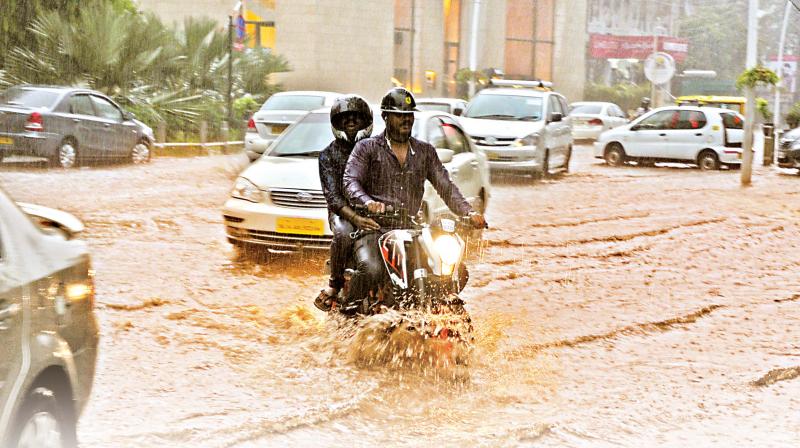Bengaluru: First came the deluge, now comes the disease
Worryingly, as many as 921 positive cases of swine flu or H1N1 too have been reported in BBMP limits in this period.

With the rains showing no signs of letting up, there has been an outbreak of vector-borne and water-borne diseases across the city. There have been 4,990 cases of dengue and 116 cases of chikungunya since January in Bengaluru alone. Experts blame it on the lack of awareness among people and the general apathy of the BBMP when it comes to keeping the city clean. The problem needs to be dealt with on a war footing. Joyeeta Chakravorty and Chandrashekar G report.
First the deluge and then the disease. Having received a record rainfall, the highest in 115 years this monsoon, which has left its roads and homes flooded and even washed away a few people , Bengaluru is now witnessing the inevitable outbreak of disease. With rain water refusing to run off in some localities with their blocked drains and large potholes, there is a bigger than usual influx of mosquitoes and a spike in vector-borne diseases like dengue and chikungunya. People are also coming down with gastroenteritis, typhoid and jaundice, leaving doctors and hospitals working overtime to deal with the rush of patients coming to them.
“In my 25 years of practice, I haven’t seen so many viral fever cases. It is difficult to tell whether they are climate related or not, but if you look around you can see there is water stagnation everywhere and mosquito control is extremely poor. It is a vicious cycle as neither the public nor the BBMP seems to care. There is a lack of awareness among the people and apathy in the BBMP,” regrets Dr Manjunath K.N., consultant, internal medicine and geriatrics, Vikram Hospital. “Then there is chikungunyaa and viral arthritis. And of the five to six dengue patients coming to us every day, some 60 per cent require hospitalisation,” he reveals.
“There is a typhoid outbreak and it is primarily water-borne. There have also been a few cases of jaundice due to Hepatitis A, which too is water-borne,” says Dr Rakshay Shetty, head, paediatric intensive care services, Rainbow Hospital. “We see at least four to five dengue admissions a day as well. A majority are from nearby districts and states," the doctor discloses, strongly recommending that people ensure hand hygiene and drink clean water to keep safe.
“Often food like chutney, which may be prepared with unclean water, transmit these diseases. It can spread from hand to hand and so hand hygiene is very important,” he stresses.
“The sudden erratic rainfall has led to a spurt in both water-borne and vector-borne diseases, besides allergies,” agrees Dr John Ebenezer, Medical Superintendent, CV Raman Nagar General hospital, which is seeing a spike in the gastroenteritis and food poisoning cases coming to it, besides some 10 to 15 dengue cases and around 10 cases of chikungunya every day.
And if you are someone who enjoys getting the wet in the rain, don’t. Doctors strongly advise against it, warning that the rain water could be contaminated with bacteria and viruses filling the air. Says Dr Raghu, senior consultant, Dr. Agarwal’s Eye Hospital. “The monsoon makes the air humid and the cools the city. But you also find bacteria and viruses becoming more widespread this season, leading to increase in cases of conjunctivitis, sty, dry eyes and other ocular diseases. So getting wet in the rain is a strict no.”
There is definite cause for concern as going by the state health department’s records the city has seen 4990 positive cases of dengue and 116 of chikungunya since January. Worryingly, as many as 921 positive cases of swine flu or H1N1 too have been reported in BBMP limits in this period, making the need for precautions this monsoon all the more important to keep these diseases at bay.
Bengaluru flooded? Blame it on lake encroachments
Bengaluru should not in the normal course be seeing any flooding in rain as it is located at an elevation, much above the sea level, points out urban expert R. K. Misra, blaming the encroachments of its lakes and rajakaluves, for much of its troubles.
“Between 1980 and 2016 most of the lakes were taken over and trees were felled indiscriminately, turning the city into a concrete jungle. As a result in 2017, nature reclaimed the lakes and the houses are floating on them. We thought we were smarter and could fool nature, but didn’t realise it could strike back with a vengeance,” he says.
“This is a warning by nature. At least now the government and the babus need to wake up. Any delay or ignoring of this warning could cost us dear in future. The greed, corruption and shortsightedness of the government and urban planners have put Bengaluru in this sad situation,” Mr. Misra deplores, strongly suggests that the city’s remaining tank beds, lakes and valleys should be made a strictly no development zone.
“They should be secured and maintained. The laws should be so stern that no official should be able to bow to pressure and allow development in these parts. This is the only way to prevent the flooding in rain,” he emphasises.
In his view no construction should be allowed in low lying areas like Koramangala, BTM layout, Kurubarahalli, Nandini layout, Mahalakshmi layout, and Sudhamanagar, which are prone to flooding.
Recalling that once the city’s lakes were interconnected with rajakaluves,he regrets that rampant encroachment has destroyed this system, leaving the city vulnerable to flooding.
“While the government promised to spend Rs 800 crore on remodelling the Storm Water Drain network, it took about 15 months just to finalise the tender. And even when the work is taken up , it is often during the rainy season, which makes the situation worse,” he adds with regret.

